Circle of Hands by Halloween Jack
| 1 | Original Metal |
| 2 | Iron Folk |
| 3 | Forging Steel |
| 4 | Ventures |
Original Metal
Original SA post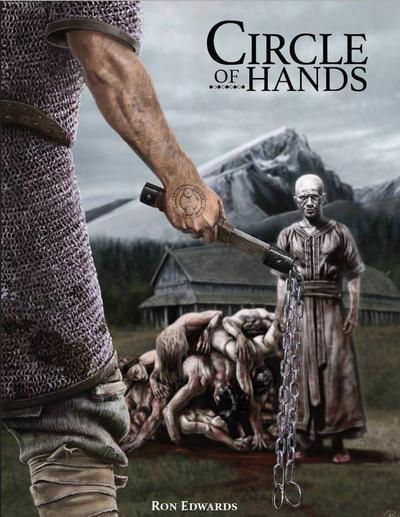
Have you ever heard of Ron Edwards? He’s kind of a big deal. Author of the games Sorcerer and Trollbabe, among others, and co-founder of The Forge, where he published the infamous essays System Does Matter, Fantasy Heartbreakers, and More Fantasy Heartbreakers. Among others. If you’re not familiar with the concept of a Fantasy Heartbreaker, well, this is the F&F thread. Wait another page or two and it’ll come up.
It turns out that the whole time Edwards was discussing fantasy heartbreakers, he had a long-forgotten D&D homebrew, called Gray Magick, just sitting there in a manila folder. So he started a little project called the Heartbreaker Redemption Project on the Adept Press website, where he encouraged people to dust off their own heartbreakers and develop them. In 2014, Gray Magick was Kickstarted into Circle of Hands.
Edwards lists a lot of inspirations throughout the acknowledgements and first chapter, far too many to repeat here. Suffice to say that his influences within the hobby run from old school (The Fantasy Trip) to groundbreaking (Prince Valiant) to indie narrative (The Shadow of Yesterday) and even OSR (Lamentations of the Flame Princess). Literary influences include Moorcock, Poul Anderson, Sienkiewicz, and Karl Edward Wagner. He also recommends some philosophy, namely Wittgenstein and Nietzsche, and notes his inspirations from 70s prog rock (the title is a Uriah Heep song). That’s not really my scene, but I promise I’ll write as much of this as I can while stoned to the gills and listening to Sleep.
Okay Just Tell Me What It’s About You Pedantic Asshole
Right.
Circle of Hands is set in a fantasy realm called the Crescent Land, an isolated region which forms the coast of a large bay to the east. Its people call themselves the Iron Folk. Their society is pre-medieval: primitive, poor, and violent. Culture is brutal and stagnant, not least because of the eternal war between black magic and white magic.
Black magic, called Rbaja (ur-bah-juh), is the force of chaos and pestilence. It maims and kills, inflames human passions to run out of control, raises vile undead, and summons insane demons. Left unchecked, Rbaja creates blasted wastelands full of rot and disease.
White magic, called Amboriyon, is the force of sterile purity. It heals and protects, quenches passion, summoning ruthless avatars and transcendent eidolons. Left unchecked, it creates idyllic cloud-citadels that call the people and lands below into a blinding light from which they will never return.
Most people are inclined to favour white magic over black magic, for obvious pragmatic reasons. But both are abstract cosmic forces that are ultimately incompatible with human life. Look at it this way: If wizards of Rbaja are Charles Manson, wizards of Amboriyon are Jim Jones.
Where You Come In
In the craggy coastal region of Rolke, something new is happening. A young king has seized power in the wake of decades of terrible magical wars, advised by an aged wizard who has somehow been practicing both kinds of magic without serving either side. The king has purged the land of wizards and declared a new strategy: use both kinds of magic, tactically, to oppose both Amboriyon and Rbaja.
A group of exceptional individuals has gathered around the king in Rolke. They are some of the best fighters in the Crescent Land, and they all know a mix of white and black magic. They are the Circle. Your PCs are knights of the Circle.
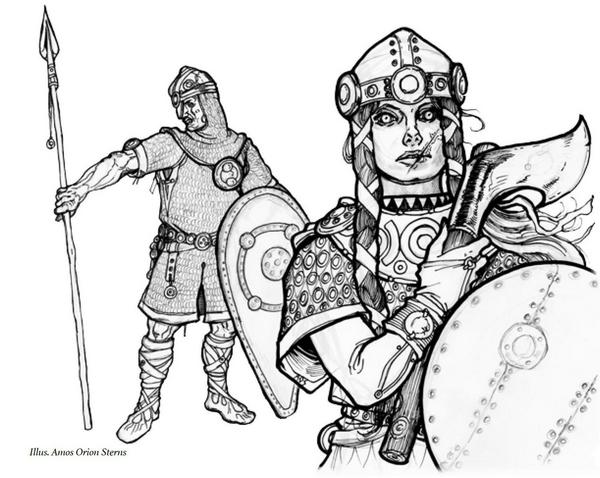
Sessions of Circle of Hands take the form of Ventures carried out by knights of the Circle. That means that a few Circle knights, that is you, heard about some problem or opportunity and rode off together to deal with it. Ventures are successful by default, usually; the game is about the impact it has on your characters and how they develop. The game is not about the political situation in Rolke. The king and his court are never depicted, and there are no rules concerning factions or domains.
Style and Content
Edwards’ voice and style in this book is unique, and I like it a great deal. He’s conversational, and sometimes he just drops references to help you visualize the world--“I was thinking of Seven Samurai when I wrote this,” etc. The layout is sometimes a bit rambling, because he likes to include things like sidebars with a playtester’s take on his ideas, or give a broad overview before getting into details. Case in point, the first chapter starts with an Rundown (PDF) that lays out the game, its setting, and its rules in a couple pages.
Let’s get this out of the way before we go any further: This game is set in a brutal pre-medieval society, and the background material frankly discusses injustices such as cold-blooded murder, rape, and torture.
Edwards insists that “Circle of Hands is about survivorship, not victimhood.” He states that he’s disgusted by the way that mass media harvests stories of trauma and commodifies them, and wants this game to be about confronting trauma, rather than exploiting it, via stories about hard people making hard choices. Later in the book are detailed procedures for setting boundaries and developing a consensus at the table on how to deal with these issues, if at all.
Chapter 1: Original Metal
This is Dark Age fantasy. Historians don’t use that term anymore, but it applies. The landscape is beautiful but sparse, and action concerns monsters, magic, and combat.
Fantasy of this sort is often called Viking Age or Anglo-Saxon, but this isn’t ancient Scandinavia or Britain with the serial numbers filed off. (Edwards says at it’s closer to the 10th century Baltic, of which I know nothing.) There’s no equivalent to the Roman Empire, as a touchstone for past glories, and no guarantee that this is all leading to chivalry or the Renaissance. If you want progress, you can start by killing that wizard over there.
I think the biggest buy-in for players of this game is that the institutions of the high medieval era, and whic you expect of a typical D&D campaign setting, simply haven’t developed at all. There’s no feudalism--no lord, no serfs, no manor. There’s no monolithic religion--neither a Catholic Church nor the quasi-Roman ecumenical paganism of many fantasy campaign settings. The cutting edge of military technology, no pun intended, is mail hauberks and steel swords. There’s no settlement big enough to be called a city. There isn’t even any money!
So what do you have instead? Government is entirely local. Economy and society are managed by norms and customs, with hierarchies forming based on personal histories and relationships. Does this system, if it can even be called that, leave a lot of room for disagreement, jealousy, resentment, bullying, and simple misunderstanding? Isn’t it under constant threat of breaking down into violence and terror? You bet. When the game isn’t about bloody struggle, it’s about the Circle knights dealing with a lot of scared and vulnerable people, most of them just trying to get by and get along.
GMing this Beast
It wouldn’t be a Ron Edwards joint if there weren’t prescribed methods for how to structure play, with diagrams.
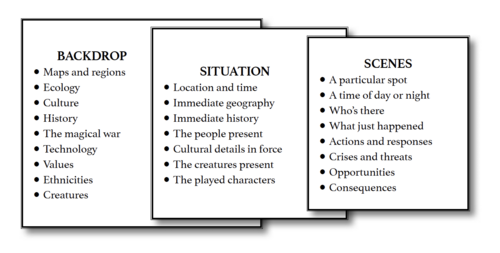
GOTO sword
This is how Circle of Hands establishes setting. The backdrop is what the book gives you in the way of what a typical RPG calls its setting chapter, plus whatever details you fill in. The situation is what the group has prepared for play: the details of the latest Venture that the GM has prepared for this session, and the PCs that the players have created, with their history from previous sessions. The scene is where play actually happens.
Edwards makes these distinctions not only for the sake of organization, but to help establish the social contract at the table. Ron is responsible for the game’s backdrop. Everyone (but especially the GM) is responsible for the situation. Everyone is definitely responsible for how they play out scenes. He distinguishes two styles of dealing with controversial content, called No One Gets Hurt and I Will Not Abandon You. In the former, limits are made explicit from the beginning, and avoided in setting up situations and in play. In the latter, the players make each other aware of their feelings and are expected to respect one another, but not to outright avoid difficult issues. Circle of Hands is built around the latter.
Two specific techniques for handling content are Lines and Veils. Simply put: a Line means that you don’t want something in the fiction, at all. A Veil means that you don’t want it depicted directly. That is, it can be part of the backdrop or the situation, but not depicted in scenes of actual play.
(At this point I just want to say that I feel like I’m overselling the Mature Content a little. You can easily play this game without anybody getting raped or crucified. There are no rape monsters or whatever in this game, just frank reminders that oppression in the Middle Ages could be horrifying.)
Edwards even says “I’m butting into your game and establishing some Lines of my own, because I can’t imagine running Circle of Hands without them.” He simply calls them Plot Armor. These are:
1. Circle knights don’t die of infection. They theoretically could in this setting, but fuck that.
2. Sex doesn’t happen without the player initiating it.
3. Circle knights don’t get pregnant unless it’s the player’s idea.
4. Circle knights don’t get raped. They theoretically could in this setting, but fuck that a million times.
So why even propose dealing with this content in play at all? Edwards’ justification is that he wants to tell fantasy stories that are about the messiness and complexity of people and their lives, instead of one where going on an “adventure,” slaying monsters, and getting treasures is just a procedural. Amboriyon and Rbaja both claim that they’re good and evil, respectively, but both are abstract cosmic forces that are literally incompatible with the reality that humans live in. The Circle dealing with these forces while opposing them is basically symbolic of the need to create ethics and do some good in the world, against ideologies that are just imposed by force.
Why This Game?
Edwards wrote the game for the same reason anybody writes yet another fantasy game: You look at everything you can find, but feel there’s something you want that’s still missing. All of that got crammed into Circle of Hands, including some big ideals and a lot of little things. He wanted a game where combat felt desperate, damage feels like it hurts, and the value of a knife vs. a battleaxe was relevant to the situation. He wanted wizards to be crazy and weird and for magic to be alien and terrifying. He wanted to care about the characters, and for them to have real reasons for struggling and fighting. He wanted cosmic forces opposing each other without the PCs feeling like pawns.
Okay, enough pontificating. Next time I’ll talk about mountains and horses and axes and stuff. I’ll be trading off updates with Vampire, which will be getting back on track soon.
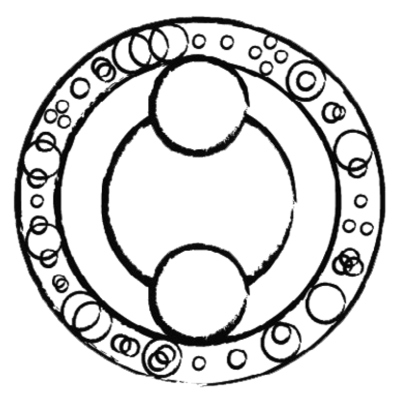
Iron Folk
Original SA post
Circle of Hands
Chapter 1: Original Metal
Chapter 2: Iron Folk
“Iron Folk” is what you’d call the setting chapter of Circle of Hands. Edwards thinks that what we call “setting” crams too much together, from the broadest social context to specific customs. So this is what he calls the backdrop--the geography and culture of the Crescent Land.
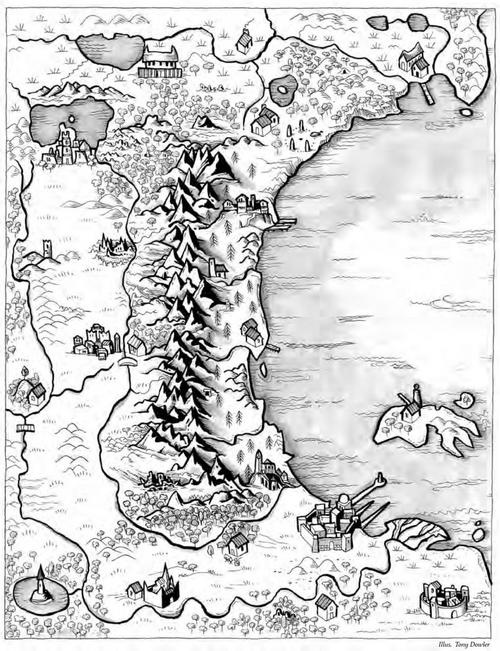
The Crescent Land and Its Regions
The Crescent Land is so named because it’s a coastal region surrounding a large bay to the east. It’s mountainous along the northern edge and enjoys a mild climate, with infrequent coastal storms and heavy snowfall only in the mountains. It can be divided into four regions, based on culture and geography--there are no borders, because there’s no rule beyond the local.
Tamaryon is the inland region running north-south, a land of plains and rivers and farming communities. Their culture includes the makings of something like a Norse thing, but is constantly disrupted by Amboriyon and by violence spilling over from Famberge.
Famberge is made up of forests and swampy coast. It’s by far the most violent region, defined by constant raids, turf wars, and power changing hands by assassination. Amboriyon and Rbaja are deadlocked here, but manipulate and contribute to the ongoing misery.
Spurr makes up the southern coastline and is the most developed with regard to sailing, trade, and a settlement big enough to actually be called a town. Power is wielded by many small estates, often exercised via coastal raiding. Rbaja is strong here--some of those estates are run by liches.
Rolke is forests and mountains with some coastal fishing villages. Most communities here formed in naturally defensible (i.e. rocky) locations. It’s culturally similar to Famberge, or it was--the young king in Rolke and his Circle Knights are a sharp break from generations of squabbling gentry.
The People
The Crescent Land is isolated by geography and the low level of development. There is some migration and commerce with the outside world, it’s just not having much impact. The people call themselves the “iron folk.” They’re descended from various peoples who immigrated centuries ago and conquered the native people, called the Pananthuri. They were tall and lean and didn’t forge iron, and haven’t left behind much besides their genetics and a few customs, like tattooing.
The Iron Folk are distinguished by light skin (that tans quite dark), tall foreheads, high cheekbones, straight or wavy hair ranging from brown to blonde, and blue or grey eyes, often with epicanthic folds. But there are many exceptions. Someone with unusual features is just that, unusual, as there's no concept of race. If Eckbert has dark skin and eyes and hair, you might call him Eckbert the Black--but only to distinguish him from Eckbert Longshanks and Eckbert the Red Haired.
Class, Wealth, and Economy
The most important thing to understand about this setting--and the most difficult--is how basic facets of life like work, wealth, status, and identity play out without the rigid codes and institutions that define those things in the modern world. Beliefs concerning property, status, religion, gender, and so on are deep-seated, but there’s no body of law you can point to.
So how do people produce and consume? People have a shared expectation that everyone works and is provided for. If you’re part of a community you have daily work, and meals and a place to sleep, and people to share it with. When you need something--clothes, shoes, candles--you ask for what you think is your fair share. But make no mistake, this isn’t a utopia of peasant communes. People disagree, nothing ensures that arrangements are fair, and in any community some people are getting screwed while others live well at their expense.
You’re probably thinking, “So everything just runs on a vague consensus of what’s fair? Wouldn’t that just break down into feuding and violence all the time?” It often does. Most people want to live in a world without violence, but when law only comes from community standards and the point of a spear, it’s inevitable. Adding to that, this society is too poor to absorb widespread hardship. In addition to violence from within and without, famine, disease, and natural disasters drive whole villages to poverty and desperation.
Class
Class isn’t prescribed or even understood, but it’s very real. Edwards avoids using words like “serf” and “lord” because feudalism doesn’t exist. The iron folk can be roughly divided into 4 emergent social classes:
Peasants are those who do the least skilled and least desirable labour. Plowing, cleaning, gathering firewood and dung--peasants are everywhere doing these necessary jobs, yet somehow invisible. They rarely travel far, unless for work (such as herders and low entertainers) or fleeing from violence.
Freemen aren’t above doing peasants’ work, but typically have some more specialized skills and thus have a voice in organizing and assigning work. With good organization, freemen are a strong base for social activism or a militia that can actually defend a village.
Professionals are best understood as people with rare and valuable skills, or contractors for skilled and dangerous work. They are recognized via patronage from gentry and privileged living conditions.
Gentry are defined, first and foremost, by not laboring to live. Those who are born into this class have their education based around warring with other gentry.
Gentry are the class most varied by region. In Famberge, they are mobs of brutal raiders. In Tamaryon, they emerge as the leaders of clan networks. In Spurr they are the most mercantile: trading-and-raiding seafarers. Rolke is experimenting with the idea of a knightly class based on allegiance to the king rather than background and wealth. (That would be you, the player characters.)
Without feudalism, titles like “duke” or “thegn” don’t exist. Many gentry don’t have titles, just famous nicknames. “Chief” is the most common title. “Knight” is a very generic term of respect, while “baron” denotes control of a territory or a fort. A “king” is a chief-among-chiefs, and only temporarily. Being a chief is more like being a village elder, or a mafia boss, than what you and I would recognize as official titles.
(Slavery doesn’t exist in the Crescent Land. There simply isn’t the infrastructure to hold lots of people in bondage, so taking captives and forcing them to work for nothing is a good way to get stabbed in your sleep. Even if you could could do it and get away with it, it’s unthinkable that it would be hereditary. This isn’t because of deeply held values of liberty and human rights--it’s just not practical or sensible.)
Class is perceived as fundamental, but it’s very mutable from one generation to the next, with as much as 10% of people falling into a different class from their parents. That’s not necessarily progress. Sure, sometimes a promising urchin is mentored by an expert artisan. But wealth and status are often gained and lost by successful raiding, bloody coups, and fleeing from said raids and coups--not to mention famine and disease. Class is also personal: it’s how you present yourself and what you can successfully claim; you don’t get to be considered gentry just because your brother is. (If you’ve ever watched Vikings, consider how Ragnar Lodbrok goes from being a simple farmer to a successful raider, which sets off a violent feud with his lord and creates a bitter rivalry with his own brother. )
Class will be really important when we get to the chapter about how adventures play out. Long story short, people will grant you hospitality, and expect things from you in turn, based on your perceived class.
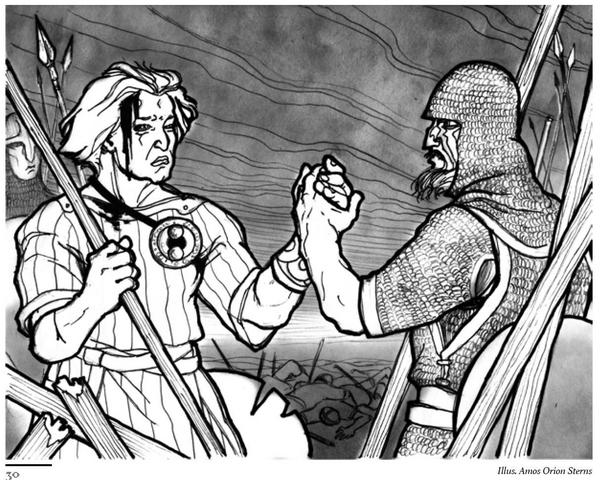
Law and Justice
Law is a matter of customs and community norms. The most commonly recognized and punished crimes are theft, shirking work, passing off inferior goods, betraying family or clan, and all forms of assault. Often, the victim or their family just avenge themselves on the perpetrator, and this is either accepted by consensus or kicks off a new wave of reprisals.
When it comes to more organized punishments, prisons aren’t practical. The most common punishment is ostracism, allowing someone to continue to live and work without the benefits of friendship and a voice in the community. The most extreme form of this is outlawry, where a person is stripped of all rights and ejected from the community entirely. This can be an invitation for someone to kill them, or a slow death by exposure or starvation. It’s possible for an outlawed person to start over somewhere else--forty miles away might as well be another country.
Clothing and Appearance
Although the fit and quality varies by social class, all clothing follows the same basic pattern. Men wear a long, belted tunic-shirt over an undershirt, and trousers for cold weather or appropriate work. Women wear long, often low-cut dresses over a blouse. Many people wear a sewn badge to signify a profession, rank, or family. Both sexes wear cloaks in cold weather.
Men cut their hair short or cheek-length. Facial hair is a matter of style, but a clean-shaven face is rare and connotes education. Women mostly braid or bun their hair, with many different styles connoting their social rank.
The culture is modest, and moreso for women than for men, but nudity is not taboo. If a man walks in on a woman changing clothes, for example, he’d apologize and leave, but no one would be scared or ashamed.
Gender, Sex, and Family
Gender roles are deeply entrenched. Women do own property and speak freely, but custom says that a daughter is under her parents’ authority until she falls under her husband’s. This includes sexuality, though in practice people are pretty good at getting around presumed barriers to having sex. Sometimes the outcome is no big deal, and sometimes it ignites grudges and feuds. Women do wield power, either by being the real brains behind their husband’s success, or through outstanding personal skill, usually in combat. Both cases are treated as more rare and unusual than they actually are.
The accepted family model is a man and a woman marrying and having children. But the clan, not the nuclear family, is the basic unit of society. When you marry, you join an extended social kinship that goes beyond blood relations, and this is as much or more important than your relationship with your spouse. Not everyone marries and has kids, but everyone is part of a clan.
The Crescent Land is tolerant of minority gender identities and sexual orientations--but only tolerance, i.e. there’s no prevailing cultural norm that demands persecution. It doesn’t mean acceptance. Those who don’t conform have to back up their choices with personal charisma or personal force, and those who can’t do that often live short unhappy lives.
Childbirth is frequent and special. Most women will have children, and may have as many as ten or more. Of those, perhaps seven will live to adulthood. The women of the iron folk are healthy and tough, and midwifery is an everyday skill. But there’s no anesthesia and no way to staunch bleeding, so the risk is always there in spite of the community’s best efforts.
A note on childhood: there are no innocents in the Crescent Land. Everyone who survives to their teenage years has worked, has fought in some way, has made hard choices about sex or had those choices forced upon them, has lost family to accidents, illness, or violence. People cling to their lives and their family without any illusions about fairness, which makes family ties fanatical for better or worse.
Childhood education is just what you absorb and are taught by your family. There are no schools or school systems. Gentry do foster their children with distant relations and allies, creating social networks and educational opportunities that don’t exist for others.
Though the death rate increases rapidly past 40, those who make it that far stand a good chance of living into their 60s, 70s, even 80s, getting wiser and tougher by the year and dying after a brief but rapid decline. Speaking of which, once an old person starts to decline, people tend to...allow it to happen. It’s not cruel; most people don’t even realize they’re doing it, but it’s basically euthanasia. Speaking of which…
Health
The Crescent Land is thankfully not a disease-ridden climate; cholera and plague are unknown. Isolation is the best defense. Smallpox threatens communities and influenza culls the vulnerable, but there aren’t enough people doing enough long-range travel to spread epidemics across the land. When an epidemic strikes, the only solution is to quarantine that village.
This isn’t a Monty Python movie; people are smart enough to avoid rot and sewage and don’t walk around caked in shit. But there’s no understanding of germ theory or even boiling for antisepsis. The iron folk aren’t especially superstitious, but it’s easy for them to see curses and judgements where we would only recognize coincidence and bad luck.
Medicine is extremely primitive; people’s idea of medicine is “Grandma Freja says eating garlic is good for your health.” Herbal remedies have no serious antibiotic or immunostimulant properties. Any significant puncture or laceration is going to get infected, and the person either recovers (maybe with a disabled limb) or they don’t.
The only real medical practice is euthanasia: brewing hemlock and dosing at intervals, so that someone suffering a lingering, painful decline can instead die peacefully in a few days.
Development, Technology, and Goods
People live in villages with populations of about 100-500 people, typically part of a larger network of about 2000-2500 people. These larger networks share an ecology of resources, within which people farm and trade produce and livestock and so on. Government can transcend a single village to encompass such a network. (The single largest settlement is the main port of Spurr, which has about 10,000 people including all its outlying areas.) Roads are only created through use or local effort to build bridges and such, so long-distance travel means traveling through unbroken wilderness and pathways known only to locals.
People live in cottages and gather in longhouses and halls--sometimes clay, but mostly timber frames with thatched roofs. Gentry build forts, typically only earth and wood palisades, but sometimes with stonework. The land is dotted with centuries-old towers, but the skill and organization to build new brickwork doesn’t exist right now.
Farming, as well as herding and fishing, is the core of human sustenance. Everyone farms, but those who do nothing but crude farm work are peasants. If you’re an outlaw or refugee and want to be accepted, it’s not a bad idea to just walk into whatever community work is being done and pitch in with no more than a hello.
As for food, it’s extremely local. The Crescent Land doesn’t have maize, but plenty of wheat and rye, which are made into many varieties of bread and porridge. No potatoes, but all kinds of other root vegetables from burdock to turnips. Also many varieties of beans and cabbage. Fruit is mostly berries, grapes, and varieties of peach. Salt and honey are necessary and valuable additives. All kinds of meat are eaten including beef, pork, mutton, poultry, fish and shellfish near the coast, and game meat like venison and hare. A lot of husbandry is following herds seasonally rather than keeping them in one place.
The iron folk keep all kinds of animals. Everyone has experience with animal husbandry, and rarely get hurt by projecting human attitudes onto animals. Speaking of which, there’s no concept of animal rights. People adopt some animals as pets (especially dogs and hawks) and animal cruelty is considered disturbing, but animals exist to provide labor, meat, and other products for human benefit. They're likely to be killed once they outlive their usefulness.
Fire and fuel are a constant feature of daily life. To the iron folk a home is defined as a building with a hearth, and a fire is always going even if it’s just smoldering embers in the summer. (Wood is thus also an everyday concern: gathering kindling, chopping firewood, and setting aside good timber for furniture and buildings.) Light is mostly a matter of daylight. Glassblowing exists, but not to the level of making bulbs or windowpanes. Candles and clay oil lamps are as far as lighting goes.
Leather is used everywhere: belts, hats, straps, shoes, patches, tarps, saddles, even buckets. Boiled and shaped leather is common, but leather armour hasn’t been invented.
This is an Iron Age world, and most metal tools are made from wrought iron, forged in bloomeries. Gold, silver, and copper are inherently valuable because they’re hard to get, and worked items made from them are the closest thing to currency.
(The closest thing to coins are big copper tokens traded by the mercantile families in Spurr. They basically represent contracts between people who know each other, so they’d be no good to you even if you could steal one.)
Steel can be made by carburization: heating wrought iron in charcoal, then quenching it in water, so that the outer layers absorb carbon and become steel. This brings us to…
Weapons
The cutting edge of military technology (no pun intended) is the one-handed steel sword, the crossbow, the mail hauberk, kite shield, and spangenhelm, made of steel panels riveted together. But a steel sword is the most valuable thing most people have ever seen. Most fighters have to make do with no more than an axe or spear, a crude round shield if they’re lucky, and an iron cone helm if they’re very lucky.
The spear and round wooden shield are the universal weapon of all social classes. Spears can be thrown or wielded by and against horsemen, but specialized varieties haven’t developed--aside from its inherent advantages (e.g. reach) spears are universal because they’re cheap to make, and discarded once damaged in combat. Shields are also throwaway items.
There are no polearms, two-handed swords, maces, or warhammers. Those are specialized weapons for dealing with plate armor, which hasn’t been invented yet. There are also no longbows or complex laminate bows; short bows are used more often for hunting than in combat. “Exotic” regional weapons include the two-handed ax, francisca, and chained flail.
People don’t go around wearing weapons and armor. They are kept in an armory or a wagon until it’s time to use them, even swords. People moved to spontaneous violence grab the knife in their belt, or improvised tools such as hatchets, staves, whips, crowbars, and other dangerous tools. Putting on mail and helm and sword is an announcement that you intend to kill somebody right fucking now.
Spirituality
Here is something unique, in my experience: the section on religion doesn’t even get into gods, symbols, religious orders, or specific practices. All of those things can vary wildly from one village to the next. It’s entirely about basic patterns of belief and the role of religion in society.
The faith of the Crescent Land is akin to primordial, non-institutional Buddhism: life is harsh and no god is protecting you. The best you can do is develop personal ethics and a sense of decency. Although there’s a myriad of local symbology and ritual, this religion doesn’t care much about metaphysics, or contacting the divine, or religious ecstasy. It’s about being kind to people and bearing suffering with grace.
At first glance, this is a slave morality: take it on the chin and don’t make waves. But it’s also a social connective tissue that can help people build power and solidarity that persists and strengthens in spite of the disruptions brought by famine, epidemics, war, and magic. This religion is hostile to both black and white magic at every level.
There’s no monolithic church, no scripture, and no priesthood that sets itself apart from everyone else. People practice all kinds of rites and rituals for marriages, funerals, and festivals, and don’t much care if their rituals accord with the ones in the next village. These typically involve wearing a special hat, saying some words, doing a little display, and sacrificing some food.
A priest, then, is just somebody who’s so good at this stuff that it becomes a part-time or full-time job. They officiate at gatherings, provide counseling, and answer difficult questions about the nature of life. They wear a badge announcing their profession and own their own funny hat. Priests are also known for extracting hashish from cannabis.

People respect priests (or not) on a personal level; they’re not representatives of any higher authority. To be fair, some priests do become serious intellectuals, write scholarly texts, and attract others to come mentor under them. These may even create renowned centers of learning that persist after the sage’s death. (The few literate people like writing down and collecting the sayings of priests, so there’s a huge library of religious doctrine scattered throughout the land, just waiting to be collected by someone with the means.) Though each priest’s practice is unique, like gentry they fall in broad category by region.
In Famberge they run the gamut from being the stooges of abusive gentry, telling people that submission and suffering are their lot in life, to actively organizing peasant revolts.
In Tamaryon priests are social organizers, often kin to the chief and plugged into their power network. They often organize militias, often to fight Amboriyon.
The priesthood in Spurr is especially scholarly and customarily older women, who are organizing more and more against the Rbaja that has infiltrated the culture.
Rolke is in the middle of a religious crisis. Priests abominate magic, but many can’t help but support the Circle’s efforts to black and white magic to fight both Amboriyon and Rbaja.
Funeral rites
Because black magic raises the dead, proper burial is a top moral obligation, and all funeral rites take on overtones of the magical war. All bodies have to be dismembered or broken at the knees, elbows, and neck. This isn’t disgusting; in fact, it’s a horrifying taboo not to do it. After that, most bodies are partially cremated before the dense muscles and bones left behind are buried. Funeral rites are accompanied by a celebration of the deceased person’s social ties, and always by singing.
Gentry tend to practice their own funeral customs. In Famberge, total cremation (which takes a lot of wood and a couple days). In Tamaryon, burial mounds. Spurr gentry prefer burial at sea, while mountainous Rolke practices sky burial.

The iron folk make all sorts of beer and wine. Distilling is a prized skill, used to make varieties of what we’d call schnapps or akvavit.
People smoke a lot of herbs just because they smell good. There’s no tobacco. There is cannabis, but it’s quite weak. Priests traditionally extract resin from the cannabis to make hashish, which is smoked in a distinctive long pipe. Most smoking involves heating the herb in a bowl over a low flame in an enclosed space. Bubblers for smoking are rare and valuable.
There’s no good way for dealing with addiction. The most common way is to gradually cut down and then deny the addict the ordinary helping that other people get. Unfortunately, this tends to result in misery and desperation for the addict and their dependents, and often to the addict dying of exposure somewhere.
Literacy
Very few people are what we would call literate. Instead, people are intimately acquainted with the signs, symbols, and counting methods relevant to their profession, such as tally sticks, various forms of abacus, and markings on woven rugs or writings on bone.
The truly literate become so through close personal mentorship; that and the literacy itself connects them to a broad but scattered community of literate people. Couriers carry letters, essays, and perhaps religious texts between scholars. There is no paper, only parchment, and no bookbinding; a “book” is a hefty leather case full of scrolls, and quite valuable.
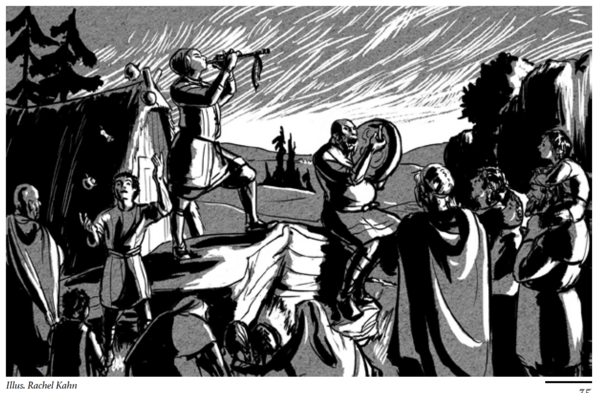
Entertainment
Music is a part of daily life, including a lot of work singing as well as singing at social gatherings. The most common instrument is the drum, along with pipes and lutes. There are horns, but without any valves or stops, they’re used for signaling and ceremony rather than music. There are no lutes or reed instruments. Dancing is usually simple but comes in many variations for different occasions and social classes. People do it a lot, and thus are quite good at it.
“Low” entertainers make their living by coming into the village, setting up at a convenient time and place, and leading people in group fun. They aren’t jesters and don’t wear costumes. They sing, play, act out skits with a lot of crude humour, and do juggling and acrobatics. Payment comes in the form of food and shelter for a fortnight to a season.
“High” entertainers are analogous to the bard or skald, essentially poets with musical accompaniment patronized by the wealthy. They usually speak-sing and play in alteration, and their poems are long and complex works that encompass legends and histories as well as amusing rhymes and riddles. They usually play harps or lyres, with ouds and zithers being much more rare. Their oral tradition doesn’t much overlap with written scholarship, but someone somewhere is probably trying to record all this stuff.
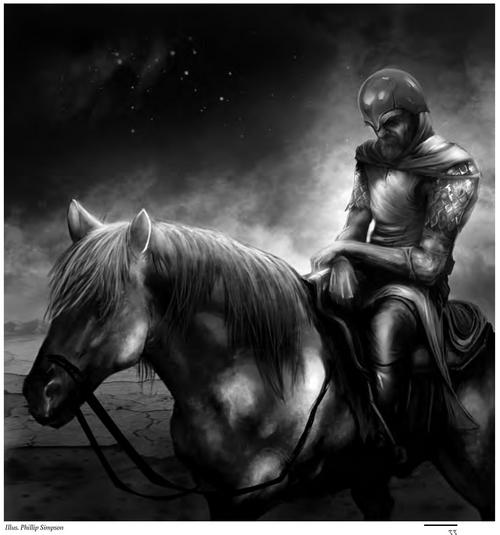
Violence
Having talked about weapons of war and why violence happens, I’ll talk about how that plays out.
No one in the Crescent Land has a fighting force big enough to be called an army, and most fighting isn’t what you’d call a battle. Most offensive actions are raids, carried out by well-trained, well-armed warbands against civilians who are neither, with the goal of pillaging and extortion. When a given raid isn’t focused on looting, it’s about “making examples,” “teaching lessons,” and “sending messages” through arson, rape, torture, and murder. Sometimes two warbands actually meet in battle to fight for supremacy, but a cycle of raid and counter-raid is more common, resisted by hastily-assembled militias or not at all.
Every hour of every day and night, somewhere in the Crescent Land a village is burning.
Warfare is conducted by gentry, but also by less-trained freeman militias they rally to fight for them, and by a class of professional warriors who earn their keep by fighting for some baron.
Famberge best exemplifies the hellhole of raiding warbands and desperate militias I’ve discussed. In the populous plains of Tamaryon, simmering clan tensions can eventually lead to the only real pitched battles among the iron folk, involving as many as a couple hundred people. Spurr is less violent internally, but the seafaring raiders are absolutely brutal, not only raiding and extorting but teaching “lessons” to villages who are under another gang’s “protection.” Rolke was very similar to Famberge until a brutal magical war wiped out many competing gangs and left newly-organized villages ready to support the new king.
When a gentry clan shores up power in an area, one hopes they’ll expand their power base across communities by organizing a sustainable division of labour and resources. But all too often they turn to simply extracting as much wealth as they can, enforced with as much brutality as necessary. They’ll attract warbands who depend on the system of oppression for their privileges. Communities that can’t resist become labor camps, those that try and fail are subject to mass maiming and execution. Those who flee are likely to die of exposure.
When a community is put under such tyranny for a long time, painful execution methods become the norm, namely impalement and crucifixion. Gentry who wind up on the losing end of a feud can expect even more sadistic punishments involving starvation, rape, castration, amputation, and slow evisceration.
The Magical War
The Crescent Land is also a battleground between two opposing cosmic forces: Amboriyon, a force of pure, healing light, and Rbaja, a force of darkness and decay. Parts of the landscape have become suffused with these forces: one patch of land literally sits on clouds of light, while another is a blasted, poisonous waste. These forces are powerful and uncompromising, seeking to absorb the rest of the land into themselves.
Magic is potent and difficult to hide, and doesn’t seek to hide itself. Individual wizards hide and scheme and infiltrate, but Amboriyon and Rbaja simply work their effects on anything and everything within reach. It may be that the two forces are controlled by unfathomable gods to whom wizards swear fealty. It’s also possible that they are “merely” cosmic forces opposed to each other and invoked by wizards, and that the accumulation of magic and magical zones is the result of so much scheming.
Wizards run the gamut of classes and professions, but practicing magic necessarily leads to breaking with community norms and developing some of their own. Painted and ash-marked faces in Famberge, long wild hair in Rolke, scarification all along the coast, and metal ornaments and piercings in Tamaryon. They also tend to disregard common religious symbols.
Most people’s response to magic is practical: they fear the destructive power of Rbaja, and seek the healing and purifying properties of Amboriyon. But Amboriyon is insidious. A village that tolerates black magic will soon be a blasted hellhole crawling with disease and undead. A village that embraces Amboriyon will soon be wiped out by suicide pacts, human sacrifice, and holy avatars aiming to free people from the suffering of the world.
The King in Rolke
Rolke has just emerged from an ugly civil war in which competing war chiefs were manipulated by black and white wizards. Fortunately, the war resulted in many wizards being wiped out along with the gentry clans who supported them, and an overall decrease in the effect of magic on the land.
A young king has come to power by opposing both black and white magic, refusing to join either side out of recognition that both are abominable, and that any buildup of one attracts the antagonism of the other. His advisor is a old sage who, somehow, is versed in both kinds of magic without actually giving himself over to Amboriyon or Rbaja.
The king attained power by relying heavily on non-gentry to organize resistance to raiding and wizardry across many communities. He depends on the continued trust and acknowledgment of local chiefs to maintain his status. He’s declared his intention to replenish the ranks of the leadership through personal fealty to him and his cause. He’s also declared his intention to use magic to fight magic.
Dedicated individuals have come from all over the Crescent Land to swear fealty, and the most committed become knights of the Circle. (The word “knight” in this case means someone sworn to service.) These are the player characters. Some of them may have been around to help the king attain power, while others might be more recent recruits. Whatever the case, they are the hardcore veterans of the Circle.
Everyone in Rolke is trying to figure out how this new order will affect their way of life. Rolke is only now culturally distinct from Famberge, and many gentry there think their power network supersedes that of the upstart king. The raiders of Spurr see the whole coastline as their piggybank, creating tension between the coastal and mountain communities. There are still pockets of old-school gentry and packs of thugs with different ideas about Rolke’s future. They need your player characters to wreck their shit.
So: the point of this lengthy backdrop chapter is to give the PCs a context in which they are of this world, but also rapidly changing it. Circle of Hands is meant to be a very different game depending on who’s playing and what PCs you create. In other games, PC factions like knightly orders and wizard colleges have their own character, which you can join if it suits you. The Circle’s nature is defined by the player characters.
In my game, the Circle is spreading a new syncretic religious doctrine at the point of a spear, and fighting wizards is both necessary and a means to an end. In your game, the Circle might be a fanatical order of wizard-slayers without much regard for the social changes that result from killing these bastards who need killing.
The PCs are committed to the Venture that concerns the game session, but play isn’t really about the success or failure of a mission--the PCs are better trained and equipped than almost anyone out there, and any given Venture is likely to succeed. It’s more about how they get there, based on who they are as people.
Next time: Character creation.
Forging Steel
Original SA post
Circle of Hands
Chapter 1: Original Metal
Chapter 2: Iron Folk
Chapter 3, Part 1: Forging Steel
The third chapter is about both character creation and setting up the first session. A character’s stats fit on a single sheet of paper, and that’s by design. Everyone (including the GM) creates two characters, and it’s assumed that you’ll play one of your characters for the first session and start trading characters around after that. There’s a lot of random rolling in character creation, so some characters will be flat-out stronger than others--but not overwhelmingly so, and again, you’ll be trading characters around.
First you roll up Attributes: Brawn, Quickness, Wits, and Charm. You roll 1d6+1 for each, except Brawn, which defaults to 6. (Spellcasting drains your Brawn, so for both narrative and game reasons, all PCs are hardy Muscle Wizards.) You get to raise some Attributes by taking two of the following Traits.
Brave (+2 Quickness): When in danger, fleeing is not your first choice.
Cunning (+2 Wits): You prefer to operate through deception.
Romantic (+2 Charm): You believe the world operates according to a narrative.
Ambitious (+1 Quickness/Wits): You’re determined to rise in social class.
Brutal (+1 Brawn/Charm): Physical and emotional bullying is just a fact of life to you.
Traits aren’t just descriptors or aspects that you can draw on when needed. They’re fundamental parts of your personality that anyone who knows you is aware of, and major cues for anyone to play that PC. Your home region is determined by your highest attribute: Tamaryon for Brawn, Famberge for Quickness, Spurr for Wits, and Rolke for Charm, or if there’s a tie, just to round it out.
Next you choose your Professions. You get one Profession for each 4 points of Wits, rounded up, so you could have as many as 3.
Professions are the only skills in this game. If a task is complicated and you don’t have a relevant Profession, you just can’t do it. This means that the PCs will have to work together, and build trust with the people that they meet, and not treat scenarios like a stealth/action game.
Artisan (choose something specific): making, fixing, and inventing stuff; appraising materials
Entertainer (low): Dancing, juggling, joking, working a crowd, dirty fighting.
Entertainer (high): Literacy, history, fancy high-class singing, dancing, and playing.
Fisherman: boating and shipbuilding, survival at sea
Martial (low): making camp, animal care, first aid, robbery
Martial (high): strategy and tactics, command in and out of battle, parlay, horses
Merchant: literacy, finance, management, geography, varying customs, appraisal
Outdoorsman: hunting, swimming, wilderness survival, natural history
Priest: theology, counseling, leading discussion, making hashish
Sailor: running a ship, navigation, organizing labour, survival at sea, swimming
Scholar: literacy, philosophy, language, natural history, maps
Wizard: sensing magic, knowledge of sorcery and magical creatures, all the spells
You can’t be both a high and low entertainer, nor high and low martial, nor can Wizard be your sole profession.
Your social class is determined by your lowest-class Profession. Class is immediately visible to everyone, and determines how people see you and how you see the world. When a session starts and PCs come to a new community, those of the peasant class will see whether the common folk are happy, or starving, or fearful. Those things are beneath the gentry’s notice; they instead perceive things like fortifications and how well they’re received at the longhouse.
Peasant: farmer, fisherman, low entertainer
Freeman: outdoorsman, sailor, martial (low), priest
Professional: scholar, artisan, merchant, high entertainer
Gentry: Martial (high)
You get weapons and armor according to your Professions. "Adventuring gear" is ephemeral. You’re knights, and you’re traveling with a small retinue of animal handlers, haulers, and guides. You don’t have to keep track of torches and ten-foot poles. You're also assumed to have some gear relevant to your Profession.
Peasants and freemen know how to use weapons relevant to their jobs such as hatchets, knives, and staves. Outdoorsmen also know the bow, sling, and hand axe, and low martial characters also know the spear, crossbow, and round shield.
High martial characters can use shields, mail and gambesons, helmets, bows and crossbows, and specialist weapons like the flail, francisca, and great axe. Gentry have expensive gear like a sword, spangenhelm, and a horse, and can fight while mounted. But they’ll only fight with a warrior’s weapons--sword, spear, bow, and the specialist weapons.
Even if your Profession gives you no martial training, you get training from the Circle. You can wear mail, a helmet, and a round shield, and get training in a single weapon of your choice.
Every Circle knight also knows Magic. There are 84 spells; I won’t go over them here. Spells are either black or white and rated 1-3 points. Wizards know all the spells. Other knights have spell points equal to their Wits, and must have a mix of black and white spells.
The game provides some handy starting packages for non-wizards. For example:
All-purpose: Bless, Curse (4 points)
Forest Walking: Vine, Trailtwister, Forward (6 points)
Magic Sword: Blade, Envenom, Righteousness (5 points)
Master of the Dead: Walk, White Light, Black Speech (5 points)
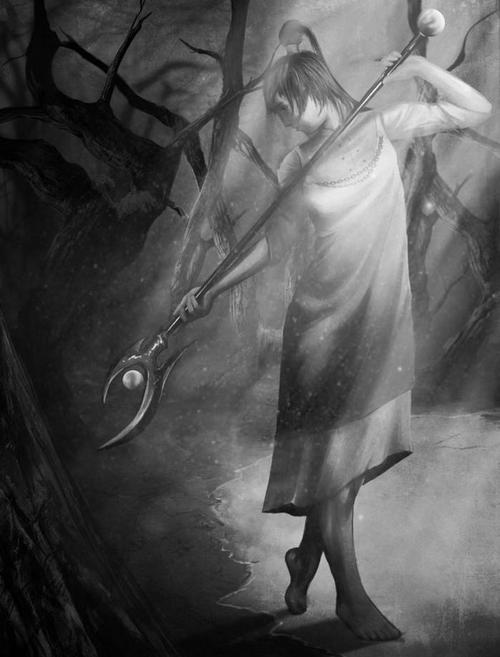
Circle of Hands began life as Ron’s D&D heartbreaker, and like early D&D, there are some interesting implications in the rules that aren’t always spelled out. For example, if you want to maximize your Charm, you are probably playing a domineering narcissist. (One interesting bit that is noted: because gameplay is only concerned with Ventures and never with the internal politics of Rolke, an Ambitious character can never realize the goal of raising their social class.) Playing a member of the gentry is attractive for obvious reasons: you get fighting skills, the best gear, and you’re at the top of the social heap! But that means having a narrow skillset and a massive blind spot when it comes to getting along with people in unfamiliar territory.
The last randomly-rolled bits are your Demeanor, Feature, and Name. For the first two, roll a d6 and add your Charm, then consult a chart. Higher results are more favoured traits, giving you an idea of what most people in the Crescent Lands value without thinking about it. For Demeanor, the results range from traits like Shy, Friendly, and Blunt to Fierce, Stoic, and Serene. Ill-favoured features include tattooing and a thin build (remnants of the primitive Pananthuri people) while impressive ones include bright clothing and metal ornaments, neat grooming, and facial scars (presumably earned in battle).
For Name, just roll 1d6. There’s a big list of Germanic names, and the result tells you what kind of name to choose, based on the meaning of the name: martial, positive (bright, beautiful, happy, etc.), sacred, or long multisyllabic ones. Name is also modified by social class: Peasants have no surnames and are called by diminutives: “Ric” instead of “Emmerich” and so on. Freemen use both forms and may have simple surnames based on place and profession. Professionals always claim surnames, and gentry are always called by a full impressive name like Brunhild Eckhart, denoting both themselves and some famed ancestor.
The final step in creating a character is the Key Event that prompted you to join the Circle. It should be brief (150 words), almost certainly a shattering experience, and probably involves magic. One given example is a gentrywoman finally defeating the mob of pirates who killed her husband and murdered their way up and down the coast, only to find that the last raider she killed is her undead husband.
There’s one last thing to do in the transition from individual character creation to setting up the group. Divide the PCs into two groups based on their total Attributes. The less-lucky half all get +1 to an Attribute of their creator’s choice, and the weakest overall character gets a supernatural Gift. I’ll go over them along with spells in a later chapter.
Next time: In the second part of Chapter 3, I’ll go over creating ventures for the Circle knights.
Ventures
Original SA post
Circle of Hands
Chapter 1: Original Metal
Chapter 2: Iron Folk
Chapter 3, Part 2: Ventures
The third chapter covers both character creation, which I went through in the last update, and creating Ventures. Remember that in Circle of Hands, play is concerned entirely with a group of Circle knights going to investigate some problem or issue they’ve heard about, and never with courtly intrigue or other matters that might be part of “downtime” in other fantasy games. Edwards advocates a low-prep method where you use random rolling to generate a location, some problems, some named characters, and some “tripwires”--more on that later--and let the adventure emerge from the PCs playing off of those things.
Like character creation, Venture generation involves rolling three dice, then combining, matching, and subtracting them in various ways to generate a template. It’s all very simple, but I’m not going to go into the tedious details about how you take the lowest die and then add it to the red die to blah blah blah. I’ll focus on the building blocks of a Venture.
To start, I roll three dice: black, white, and red. They come up 6, 2, and 2.
The first step is Location. Because two dice match, the Venture isn’t in Rolke. It’s in Tamaryon, the large inland pastoral region. I also need to come up with a name for the specific community where the Venture takes place. The options are all Germanic names, based on names and geography. If I were being cheeky, I’d go with “Altdorf,” but instead I like Luttenbruck, meaning “little bridge.”
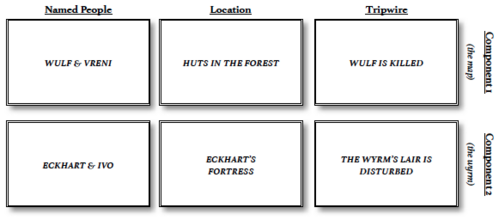
At this stage, you’re also meant to imagine this community’s daily life and struggles, and as many little details of its culture as you like. I’m thinking of a farming community, not of particular strategic or economic importance to the surrounding region, somewhat backward and insular because it suffers mightily ever couple generations when the floods are bad enough to surmount the bridge.
The second step is Components. These are the problems the Circle knights will be dealing with, and the method generates 1-3 of them. Some of them are crises that the knights will try to resolve in order to build goodwill. Others are opportunities the knights will try to take advantage of. And Amboriyon and Rbaja are forces the Circle opposes on principle, with no expectation of reward.
Humanitarian crisis: War, oppression, famine, disease, or natural disaster. Edwards wants you to focus on human agency in causing or responding to it.
Social tension: Conflict between the social classes has reached the breaking point. Poverty, clan feuds, and humanitarian crises play well into this. Circle knights confuse social rank just by being there, and knights from the region will have some insight into the conflict.
Opportunity: The Circle sees a chance for peace, trade, or any other kind of cooperation with the community. This should be a milk run, but it’s easy to screw up.
Knowledge: Some foreign or lost technology, a map, a revelatory fact, or something similar is in play. The fact that the Circle knows about this at all means it’s being actively contested.
Monster: A creature of Amboriyon or Rbaja, or other fantastical beast. Such creatures are never just out in the woods waiting to be hunted; they’re fixated on a community or more likely, connected to it.
Knowledge: Some valuable knowledge in the form of a strange technology, a map or book, a secret, etc. has come to the Circle’s attention. It’s not just sitting there; someone is using it or people are struggling for it.
Monster: Circle knights fight such things to earn goodwill for the Circle.
Rbaja: A Rbaja wizard, demon, or magical zone. A living nightmare.
Amboriyon: An Amboriyon wizard, eidolon, or magical zone. A light that seduces and destroys.
The dice method works out so that Ventures in Rolke are more likely to be low-intensity, and both humanitarian crisis and Amboriyon never occur by themselves. The only result I get is Rbaja. I’m imagining a vile sorcerer camping out near an isolated community.
The third stage is a quick one, using a die result to set the tone.
Harsh: Hardship, tough decisions, personal loss
Grim: Injustice, oppression, desperation
Squick: Gore, agony, atrocity
My results give me Harsh. I’m thinking of a blasted wasteland beyond the pastures, where people go and don’t come back, that the knights will have to enter to deal with the influence of Rbaja.
Next I need to determine the total number of Components. My dice give me two Rbaja components. I decide that Luttenbruck is troubled by both a Rbaja zone and the wizard who created it.
Finally, create named characters connected to each component. Since I only have Rbaja, I need three characters connected to the problem. Each character needs an 8/5/4/2 stat spread, their profession, and their social rank written down, but that’s the easy part.
Baron Heinrich Sieghild is the de facto leader of the community by virtue of his family connections to a prominent clan chief up north, and his possession of a quaint and perpetually undermanned guard tower by the old bridge. Though it occasionally wounds his pride, he’s content to do “what’s best for everyone,” i.e. what’s best for his wealthier and more powerful cousins.
Ingeborg is the spiritual leader of Luttenbruck, one of the first people to resettle after the last bad flood. In her capacity as priestess and midwife, she’s universally respected for the sheer number of people she’s mothered, grandmothered, godmothered, delivered, and/or married. Ingeborg feels like Luttenbruck still hasn’t really found its feet, and is pressuring Heinrich to make the community more well-defended and self-sufficient. She’s wise, but impatient to see big change happen in her lifetime.
Gerhard Sigvald is the town’s only skilled metalsmith. That wouldn’t be the case, but a month ago, Gerhard’s son Lambert went into the dark wood with one of Ingeborg’s granddaughters, Gerda, and didn’t come back. This has strained their lifelong friendship, and they are both pressuring Heinrich to “do something” about it.
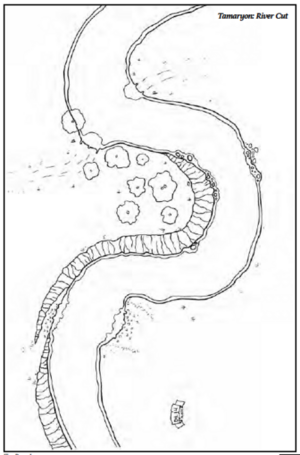
Edwards recommends maps, though they aren’t necessary. Not a big map of the whole community, but smaller-scale maps of dangerous and important locations.
The last step is tripwires. Tripwires are events with a specific trigger, with shocking and game-changing consequences. They’re not traps, or tricks, or goals for the PCs to achieve or avoid, since they don’t know about them.
If anyone else goes missing, Heinrich will be goaded into leading a search party into the woods, with disastrous consequences.
If the wizard’s lodge is disturbed, she will flee back through the woods to the village, with the intent of making a big mess, kidnapping Gerda, and fleeing.
If the PCs or anyone else interrogates Gerda, Ingeborg will close ranks and shun the Circle knights.
Edwards tells you right out that you should be aiming for “soap opera.” The NPCs just have their own lives and agendas, which get bound up in the Components and lead to action and drama. No one has to be a diabolical villain, or a lunatic, or part of a secret conspiracy in order to move the plot along. (Except wizards. Fucking wizards.)
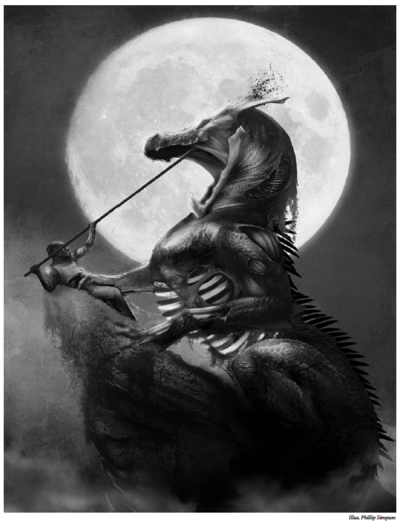
Beginning Play
A Venture begins with each player picking a knight to play. Don’t play the same knight twice in a row, but when you play a knight, they’re yours. Honor what’s been established about the character through play, but you don’t have any obligation to their creator’s original vision or anything like that. Your roleplaying prompts are on the character’s sheet--Traits, Profession, and Key Event.
The GM only tells the players what region they’re going to, and some sketchy details about the most obvious Component. You aren’t summoned to the king’s chambers and sent on a mission; the Circle doesn’t work like that. You heard about a problem and a group of you decided to get involved.
Another important thing to remember is that a great deal about your characters is immediately visible, and the people you meet are no fools: they recognize your regional accent, your Circle badge, and probably know your social rank and profession from your manner and dress. A group of people different from each other, showing up armed and with a retinue, perhaps showing evidence of being touched by both black and white magic, is something these people have never seen before.
Next time: GMing individual scenes, rolling dice, and a bunch of little stuff.